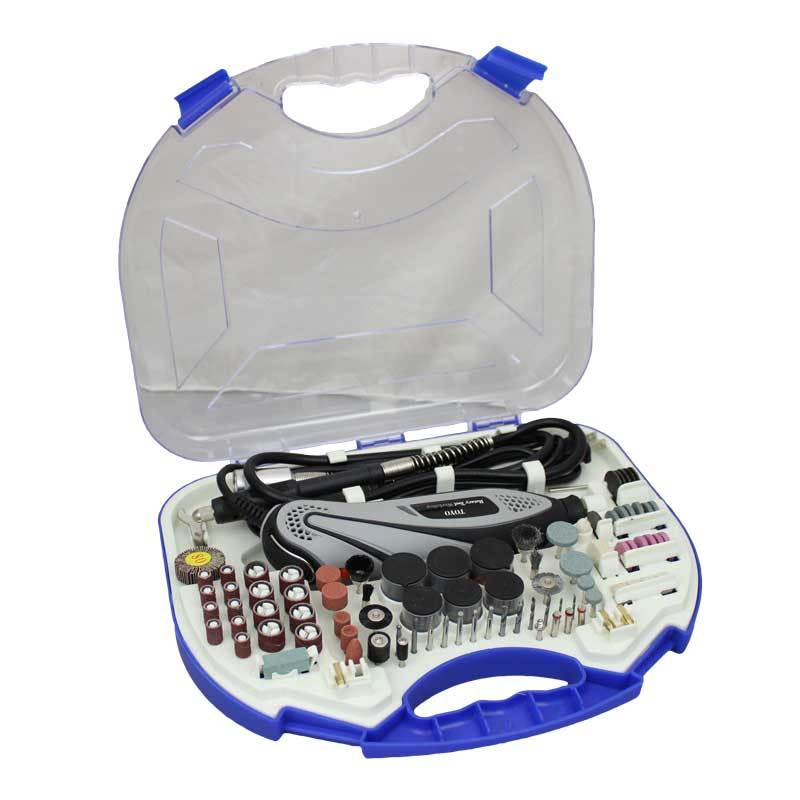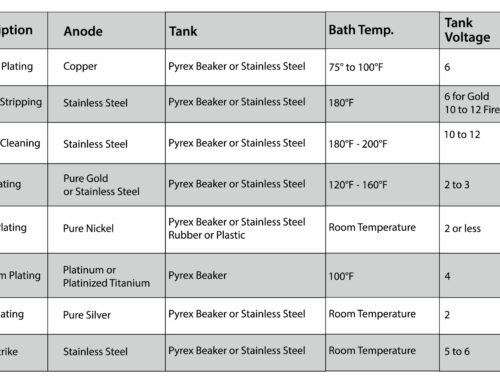Below is a collection of jewelry tools that will come in handy when you are working on repairing rings or sizing them. These descriptions will help you figure out which of these tools will be most useful to you at your workbench.
Felt Inside Ring Buff: This tool is used after you have sanded the interior of the ring to a fine finish. It is first used in conjunction with cutting compound to buff the ring’s interior. Then, using rouge, you can polish the ring’s interior with the felt inside ring buff. This tool can be attached to the tapered spindle of a polishing lathe.
Florentine Graver: A graver is used to add textures to metal surfaces. A traditional steel chisel, a Florentine graver, or line graver, creates fine lines for cross-hatching and other patterns involving lines on jewelry. They use the side with the serrated belly to retexture rings and other pieces during repair.
Grooved Ring Mandrel: Sometimes a large faceted stone may be mounted in a ring so that the cutlet of the stone intrudes on the finger hole. While not necessarily felt by the wearer, the stone may be damaged when slid onto a regular mandrel. In these cases, the grooved mandrel can be used. Line the stone up with the groove in the mandrel to protect it and get an accurate size of the ring.
Half Round/Flat Pliers: These particular pliers are very hand tools for any jeweler’s bench. One side of the jaw is flat, usually used to hold the ring or apply pressure, the other side of the jaw has a convex curve that will match the curve inside the shank of a ring. These pliers are great for shaping and holding ring shanks.
Head and Shank Tweezers: This kind of tweezers features an inward curving hook on one side and a flat pad on the other. The tweezers have a unique locking mechanism that allows you to hold pieces in place while you solder the ring.
Inside/Outside Ring Clamp: This is a variation of the ring clamp, often made out of aluminum and it features a wing screw instead of a wooden wedge to control the tension in the clamp. One end has concentric rings that expand to grip the ring from the inside that allows the jeweler access to the entire outside of the ring shank. The other end has a leather-lined jaw to protect the piece that is being held.
Inside Ring Tweezers: When you need to hold a ring from inside the shank so you can work on the exterior, this tool is just the thing you need. They feature two outward curving hooks at the tips of the tweezers and using tension, grip the ring shank from the interior.
Jewelry Marking Pliers: This is the alternative to hammer-driven punches to stamp jewelry. This tool is a specialized pair of pliers that have a place where you can change the stamp at your convenience. More accurate and easier to use than punches, these pliers are also more expensive. These pliers can make sharp but shallow impressions on the metal than you can achieve with punches.
Mesh Basket: This tool is comprised of a metal handle grip and a round mesh basket that can be completely closed to protect jewelry that has gems that may be dislodged during the ultrasonic bath or steam cleaning. The mesh basket allows you to safely retrieve any stones that might fall out of their setting while being cleaned.
Outside Ring Tweezers: When you need to grip a ring from the outside, another option besides the ring holding pliers is the outside ring tweezers. Featuring two hooks curving inwards, tension created by a sliding lock on the handle of the tweezers allows you to grip the shank securely on the outside.
Ring Bending Pliers: When working on a heavy gauge shank or a shank made of a hard alloy, normal pliers won’t give you the leverage that you need to adjust the shank. That is where the ring bending pliers come in handy. Also known as bow closing pliers, these pliers use their mechanical advantage to apply more directed force that allows the jeweler to easily move the metal. With a new pair of ring bending pliers, it is important to modify the jaws to protect the rings that you will be using the pliers on. You will need to grind down the inside of the two pronged side of the jaw, removing any sharp corners, and then cover this side with a copper or leather hood to further protect the ring.
Ring Clamp: Traditionally made of wood, a ring clamp is a double-ended, lever action device used to securely hold rings without marking the piece. The ring clamp works by a wooden wedge being inserted into one end to help close the other. Other types of ring clamps can be made of aluminum and nylon with leather-lined jaws to protect the jewelry piece.
Ring Cutter: This tool is perfect for the emergency removal of rings from fingers. One side sits between the finger and the ring to protect the finger. The other side ends in a rotary blade that you turn to cut through the shank.
Ring File: Narrower than a typical file, this file is half-round that allows you to file inside a ring shank to create the proper inner contour while removing excess metal from the ring.
Ring Holding Pliers: When it is difficult to hold a ring during maintenance on the inside of the shank, this tool allows you to grip the exterior of the shank and continue your work. The jaws of a ring holding pliers are usually lined with leather to protect the finish of the ring you are gripping.
Ring Polishing Clamp: If you find that when polishing rings they get too hot to handle there is a tool to help you out. The polishing clamp, typically made of wood, securely holds a ring on the outside to allow you to sand and polish the inside of the band.
Ring Sanding Cone: When preparing to finish the inside of a ring, it is necessary to create a smooth sanded surface. Since sanding cones come in a number of different grades, work quickly, and leave the interior of the ring perfectly round, they are the best choice when it comes to finishing a ring shank. They are mounted on a tapered mandrel, generally wooden, which is then screwed onto the tapered end of your polishing lathe.
Ring Setting Clamp: This tool comes with a set of inserts that expand to fit the size of any ring from the interior so it can be held securely and the outside is exposed so the jeweler can work on setting stones on the outside.
Ring Sizer: A set of metal rings used to determine the size of a finger. It is very important to have a complete and accurate set of ring sizers on hand. Be sure to check the accuracy of your ring sizer by sliding one size ring on your mandrel and matching the size on the mandrel to the size on the ring.
Ring Stamping Punch: In accordance with federal law, all jewelry made of precious metals must be stamped with the quality of the metal. Usually, just a hammer and a straight steel punch is needed to stamp jewelry pieces like bracelets. With rings, such straight steel punches make it impossible to make a good stamp on the inside of a shank so it is necessary to use a ring stamping punch. This punch features a goose neck, or curved shaft that allows you to make the correct angle and get a clear stamp on the inside of a ring shank.
Ring Stick: This is a variation of the steel mandrel, generally made of aluminum, plastic, or wood. These are great for measuring ring size, but not necessarily good for hammering or other repair processes.
Ring Stretcher and Compressor: A serious jeweler’s essential tool, a ring stretcher and compressor is mounted on the bench. It allows a jeweler to stretch a ring up in size or compress it down in size without having to cut and re-solder the ring. Though this is a handy tool, it cannot be used on all rings.
Rotary File: A coarse cylindrical tool used to remove excess metal from the inside of ring shanks.
Shank Bender: This tool uses an eccentric cam, operated by a lever, to help you easily shape even the most difficult ring shank material into a circle. It works by forcing the side of a steel cylinder into a steel die, using mechanical force to amplify the force that you exert on the ring.
Shank Roller: The shank roller allows you to stretch rings that you couldn’t necessarily stretch on a tool like the ring stretcher and compressor, particularly those rings with gemstones set in them. It uses a set of difference sized shank contour dies that you can mount in a handle that will apply pressure to only a selected portion of the shank. This way you can thin and stretch part of the shank without distorting the rest of the ring.
Simple Ring Stretcher: This tool works on the same principle as the ring stretcher and compressor, but it is more low-tech and less expensive. A split mandrel with a set of concentric steps holds the ring in place. This split mandrel holds the ring as a tapered mandrel is hammered into the opening at the top of the split mandrel. This forces the split mandrel to expand, simultaneously expanding the ring. Though this is an effective tool, the ring stretcher and compressor is an easier tool to use and allows you to size rings both up and down.
Soft Mandrel: When a ring is not round, whether it is due to design or a distortion in the ring, it is incredibly difficult to measure the ring’s size on a regular mandrel. Soft mandrels, made out of foam-like materials, are perfect for sizing these otherwise difficult rings.
Steel Ring Mandrel: This is an essential tool for any jeweler’s bench. A mandrel is tapered to represent a large range of ring sizes. The mandrel is marked with lines and numbers that represent where a specific size is. A mandrel can accurately measure the size of a ring and it is sturdy enough to hold up under hammering due to rounding and stretching.
Stone Grinding Wheel: A common tool, the stone grinding wheel is also used for grinding the interior of a ring shank. This tool is comprised of a stone wheel mounted on a screw-top mandrel that can be used in your flex shaft. The wheel has an abrasive surface that leaves a rough texture and is sometimes used to apply an ornamental finish to a finished piece.
Wide Ring Sizer: Similar to a regular ring sizer, but the metal rings are wider. This type of sizer is used when the ring is wider than 5 mm, as they fit on your finger differently due to increased friction against the finger.






Leave A Comment